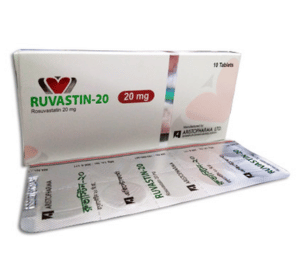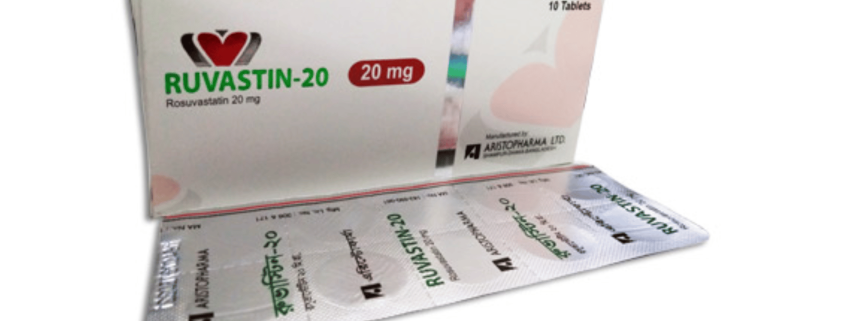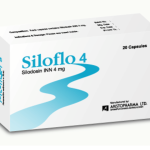Ruvastin (Rosuvastatin)
Therapeutic Group : Lipid Lowering Agent

Pharmacology:
Ruvastin (Rosuvastatin) is a selective, potent and competitive inhibitor of HMG-CoA reductase, the rate-limiting enzyme that converts 3-hydroxy-3-methylglutaryl coenzyme A to mevalonate, a precursor of cholesterol. Rosuvastatin produces its lipid-modifying effects in two ways. First, it increases the number of hepatic LDL receptors on the cell-surface to enhance uptake and catabolism of LDL. Second, it inhibits hepatic synthesis of VLDL, which reduces the total number of VLDL and LDL particles.
PHARMACOKINETICS
Absorption: In clinical pharmacology studies in man, peak plasma concentrations of rosuvastatin were reached 3 to 5 hours following oral dosing. Both Cmax and AUC increased in approximate proportion to rosuvastatin dose. The absolute bioavailability of rosuvastatin is approximately 20%. Distribution: Mean volume of distribution at steady-state of rosuvastatin is approximately 134 liters. Rosuvastatin is 88% bound to plasma proteins, mostly albumin. The binding is reversible and independent of plasma concentrations. Metabolism: Rosuvastatin is not extensively metabolized; approximately 10% of a radiolabeled dose is recovered as metabolite. The major metabolite is N-desmethyl rosuvastatin, which has approximately one-sixth to one-half the HMG-CoA reductase inhibitory activity of the parent compound. Overall, greater than 90% of active plasma HMG-CoA reductase inhibitory activity is accounted for by the parent compound. Excretion: Following oral administration, rosuvastatin and its metabolites are primarily excreted in the feces (90%). The elimination half-life (t1/2) of rosuvastatin is approximately 19 hours.
Indications:
Ruvastin (Rosuvastatin) is an HMG Co-A reductase inhibitor indicated for:
Adult patients with primary hyperlipidemia and mixed dyslipidemia as an adjunct to diet to reduce elevated total-C, LDL-C, ApoB, nonHDL-C, and TG levels and to increase HDL-C
Pediatric patients 8 to 17 years of age with heterozygous familial hypercholesterolemia (HeFH) to reduce elevated total-C, LDL-C and ApoB after failing an adequate trial of diet therapy
Pediatric patients 7 to 17 years of age with homozygous familial hypercholesterolemia (HoFH) to reduce LDL-C, total-C, nonHDL-C, and ApoB as an adjunct to diet, either alone or with other lipid-lowering treatments
Adult patients with hypertriglyceridemia as an adjunct to diet
Adult patients with primary dysbetalipoproteinemia (Type III hyperlipoproteinemia) as an adjunct to diet
Adult patients with homozygous familial hypercholesterolemia (HoFH) to reduce LDL-C, total-C, and ApoB
Slowing the progression of atherosclerosis as part of a treatment strategy to lower total-C and LDL-C as an adjunct to diet
Risk reduction of MI, stroke, and arterial revascularization procedures in patients without clinically evident CHD, but with multiple risk factors
Dosage & Administration:
General Dosing Information: The dose range for Ruvastin in adults is 5-40 mg once daily. The usual starting dose is 10 to 20 mg daily. Use 40 mg dose only for patients not reaching LDL-C goal with 20 mg. The usual starting dose in adult patients with homozygous familial hypercholesterolemia is 20 mg/day.
Pediatric Dosing: In heterozygous familial hypercholesterolemia, the recommended dose range is 5 to 10 mg orally once daily in patients 8 to less than 10 years of age, and 5 to 20 mg orally once daily in patients 10 to 17 years of age. In homozygous familial hypercholesterolemia, the recommended dose is 20 mg orally once daily in patients 7 to 17 years of age.
Dosing in Asian Patients: In Asian patients, consider initiation of rosuvastatin with 5 mg once daily dose due to increased rosuvastatin plasma concentrations.
Contrainidications:
Rosuvastatin is contraindicated in patients with known hypersensitivity (e.g. rash, pruritus, urticaria, and angioedema) to any component of this product. It is also contraindicated in patients with active liver disease, which may include unexplained persistent elevations of hepatic transaminase levels.
Side effects:
Rosuvastatin is generally well tolerated. The following serious adverse reactions may occur: rhabdomyolysis with myoglobinuria and acute renal failure and myopathy (including myositis); liver enzyme abnormalities. The most common adverse reactions that led to treatment discontinuation are myalgia, abdominal pain, nausea, headache, asthenia, and nausea.
Drug interaction:
Cyclosporine: Cyclosporine increase rosuvastatin’s exposure (AUC) to 7-fold. Therefore, in patients taking cyclosporine, the dose of rosuvastatin should not exceed 5 mg once daily. Gemfibrozil: Gemfibrozil significantly increased rosuvastatin exposure. If used together, the dose of rosuvastatin should not exceed 10 mg once daily. Protease Inhibitors: Coadministration of rosuvastatin with certain protease inhibitors has differing effects on rosuvastatin exposure. Caution should be exercised when rosuvastatin is co-administered with protease inhibitors (e.g. simeprevir, combinations of atazanavir/ritonavir, lopinavir/ritonavir, fosamprenavir/ritonavir etc). Coumarin Anticoagulatns: Rosuvastatin significantly increased INR (International normalized ratio) in patients receiving coumarin anticoagulants. Therefore, caution should be exercised when coumarin anticoagulants are given in conjunction with rosuvastatin. Niacin: The risk of skeletal muscle effects may be enhanced when rosuvastatin is used in combination with lipid- modifying doses (?1 g/day) of niacin; caution should be used when prescribing with rosuvastatin. Fenofibrate: Because it is known that the risk of myopathy during treatment with HMG-CoA reductase inhibitors is increased with concomitant use of fenofibrates, caution should be used when prescribing fenofibrates with rosuvastatin. Colchicine: Cases of myopathy, including rhabdomyolys, have been reported with HMG-CoA reductase inhibitors, including rosuvastatin, coadministered with colchicine, and caution should be exercised when prescribing rosuvastatin with colchicin.
Use in special groups:
Use in Pregnancy: Rosuvastatin is contraindicated for use in pregnant women since safety in pregnant women has not been established and there is no apparent benefit to therapy with rosuvastatin during pregnancy.
Use in lactation: Rosuvastatin use is contraindicated during breastfeeding.
Geriatric Use: Elderly patients are at higher risk of myopathy and rosuvastatin should be prescribed with caution in the elderly.
Renal Impairment: Rosuvastatin exposure is not influenced by mild to moderate renal impairment (CLcr ?30 mL/min/1.73 m2). Exposure to rosuvastatin is increased to a clinically significant extent in patients with severe renal impairment (CL<30 mL/min/1.73 m2) who are not receiving hemodialysis and dose adjustment is required.
Hepatic Impairment: Rosuvastatin is contraindicated in patients with active liver disease, which may include unexplained persistent elevations of hepatic transaminase levels. Chronic alcohol liver disease is known to increase rosuvastatin exposure; Rosuvastatin should be used with caution in these patients.
OVERDOSAGE
There is no specific treatment in the event of overdose. In the event of overdose, the patient should be treated symptomatically and supportive measures instituted as required. Hemodialysis does not significantly enhance clearance of rosuvastatin.
STORAGE
Store below 300 C in a dry place, protect from light. Keep out of the reach of children.
Packing:
Ruvastin-5 Tablet: Each box contains 30 tablets in Alu-Alu blister pack.
Ruvastin-10 Tablet: Each box contains 30 tablets in Alu-Alu blister pack.
Ruvastin-20 Tablet: Each box contains 10 tablets in Alu-Alu blister pack.



